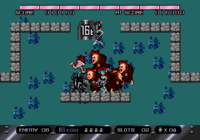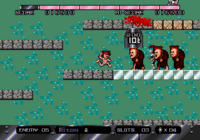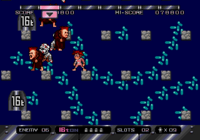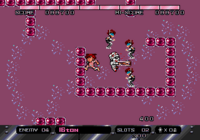16t
From Sega Retro
| 16t | ||||||||||
|---|---|---|---|---|---|---|---|---|---|---|
| System(s): Sega Mega Drive | ||||||||||
| Publisher: Sega | ||||||||||
| Developer: Sega CS1 | ||||||||||
| Genre: Action | ||||||||||
| Number of players: 1-2 | ||||||||||
|
16t is a 1991 action game for the Sega Mega Drive by Sega released exclusively on the Sega Game Toshokan service (and on the various compilations that package such games). The name of the game refers to the 16-ton weights that the protagonist throws.
Contents
Gameplay
The game is a platforming game where the player controls as a computer programmer who ventures into his own bugged program to debug it by squishing the bugs with 16-ton weights. The "bugs" resemble horror movie monsters. Each round is a series of platforms and wraps around endlessly in every direction. Enemies are dropped into the level in multiple waves, and the round ends when the programmer clears every wave. There are 21 rounds.
The programmer moves with ![]() and
and ![]() and jumps with
and jumps with ![]() and
and ![]() . He attacks enemies by throwing 16-ton weights with
. He attacks enemies by throwing 16-ton weights with ![]() . Multiple weights can be thrown rapidly with multiple button presses, but the number of weights is limited to five at a time. A meter on the bottom of the screen (reading "16-ton") quickly replenishes and provides another weight when the player has fewer than the maximum. A single weight can kill multiple enemies. Weights bounce off each other. The programmer can stand on a weight to reach a higher platform. The weight persists wherever it lands until it is destroyed; the programmer or an enemy jumping on top of it or touching it from underneath (after it lands) or another weight hitting it weakens the weight until it is destroyed. This persistence as well as the wraparound level design can cause chaotic situations, such as weights falling or sliding infinitely, and can also cause considerable slowdown.
. Multiple weights can be thrown rapidly with multiple button presses, but the number of weights is limited to five at a time. A meter on the bottom of the screen (reading "16-ton") quickly replenishes and provides another weight when the player has fewer than the maximum. A single weight can kill multiple enemies. Weights bounce off each other. The programmer can stand on a weight to reach a higher platform. The weight persists wherever it lands until it is destroyed; the programmer or an enemy jumping on top of it or touching it from underneath (after it lands) or another weight hitting it weakens the weight until it is destroyed. This persistence as well as the wraparound level design can cause chaotic situations, such as weights falling or sliding infinitely, and can also cause considerable slowdown.
Enemy waves are dropped periodically into the level from the top of the screen, wherever the programmer is. An eight-segment bar on the top of the screen "spins" like a roulette wheel, which decides the horizontal drop point of the next enemy wave. The programmer must kill each wave of enemies by throwing giant weights at them. Waves usually consist of several enemies but can contain as few as one. Enemies explode in a burst of blood when killed. The top bar spins again for the next wave of enemies when all of the enemies are dispatched; the top bar also counts down (with each segment going from colored to clear) after dropping a wave and spins again if it finishes counting down before all of the enemies from the previous wave have been cleared. Counters on the bottom of the screen show how many enemies are left ("Enemy") and have many enemy waves remain ("Slots").
The programmer is killed if he touches an enemy. He can also be killed by his own weights if one lands on him. He respawns immediately if the player has lives remaining (with the player having a small amount of time to position him in the level as he respawns using the D-Pad). The player has a limited number of lives but receives another one every 10,000 points. The game ends if the player runs out of lives, but it can be continued immediately from where it was lost at the cost of the player's score.
Blocks
| These blocks make up the majority of the platforms in the game. They cannot be destroyed. The programmer can jump through them from below. | |
| These blocks act as regular platforms, but they can be destroyed by throwing weights at them. | |
| The programmer slips when he walks across these blocks. Weights can slide across them. | |
| The programmer and weights can both bounce off these blocks. |
Rounds
Production credits
- Main article: 16t/Production credits.
Gallery
Magazine articles
- Main article: 16t/Magazine articles.
Technical information
- Main article: 16t/Technical information.
References
| 16t | |
|---|---|
|
Main page | Credits | Technical information | |
























